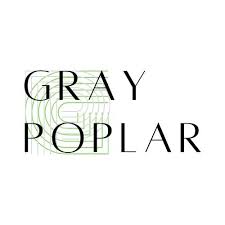Gray Poplar Online Retail: Complete Guide for Buyers and Professionals
The phrase Gray Poplar online retail covers seeds, saplings, lumber, veneers, and engineered finishes connected to the tree species Populus × canescens and to gray-styled poplar wood products. A clear understanding of the term helps professionals, landscapers, and DIY buyers select the correct products.

What Is Gray Poplar?
Gray Poplar is the common name for Populus × canescens. Botanists classify it as a natural hybrid between White Poplar (Populus alba) and European Aspen (Populus tremula).
-
Height: 20–30 meters in maturity.
-
Bark: Smooth, light-gray with darker ridges.
-
Leaves: Serrated, with a shimmering underside.
-
Growth: Rapid, suitable for landscaping windbreaks.
In online retail, the name “gray poplar” is also applied to wood boards with gray finish or engineered veneers mimicking poplar grain. Buyers must separate species-based products from finish-based materials.
Gray Poplar in Online Retail
Online sellers group products under three categories:
-
Botanical Products:
-
Seeds and saplings of Populus × canescens.
-
Cultivars such as ‘Pendula’ and ‘Tower’.
-
Sold by nurseries with zone-specific shipping.
-
-
Solid Wood Products:
-
Lumber boards surfaced S2S, S3S, S4S.
-
Poplar barn boards with “gray” finish.
-
Used in furniture and DIY home projects.
-
-
Engineered Surfaces:
-
Reconstituted veneers marketed as “Gray Poplar.”
-
Panels bonded to MDF or fire-rated cores.
-
Used in interior wall systems, doors, cabinetry.
-
Table: Gray Poplar Product Types in Online Retail
| Category | Product Form | Typical Buyers | Key Attributes |
|---|---|---|---|
| Seeds & Saplings | Bare-root trees, seed lots | Landscapers, gardeners | Zone compatibility, replacement guarantees |
| Solid Lumber | S4S boards, barn boards | Woodworkers, DIY homeowners | Color variation, surfacing losses |
| Veneers & Panels | Reconstituted sheets, crown-cut | Designers, architects | Consistency, fire-rated substrates |
Why Buyers Choose Gray Poplar Online
-
Ensure Growth Speed: Saplings reach height quickly for shelterbelts.
-
Clear Cost Advantage: Poplar lumber is affordable compared to oak or maple.
-
Absorb Design Trends: Gray finishes fit rustic and industrial interiors.
-
Follow Sustainability: Engineered veneers reduce pressure on solid timber.
-
Spend Less Effort: Online retail removes regional supply limitations.
How to Buy Gray Poplar Saplings Online
To buy Gray Poplar saplings online:
-
Check the Latin Name: Look for Populus × canescens or cultivar names.
-
Verify Zone Data: Match USDA hardiness zones to your region.
-
Review Seller Policies: Confirm live delivery guarantees.
-
Plan Seasonal Timing: Purchase during spring or fall planting windows.
Nurseries pack saplings bare-root in moisture-retaining wraps. Saplings ship dormant to reduce stress.
How to Buy Gray Poplar Lumber Online
To buy Gray Poplar lumber online:
-
Measure Project Needs: Boards range from 1/2″ to 2″ thick.
-
Select Surfacing: Choose S2S, S3S, or S4S depending on machining.
-
Review Color Variations: Poplar ranges from cream to gray streaks.
-
Confirm Shipping: Boards may require freight packaging.
Home improvement sites also list weathered gray barn boards. These differ from natural gray streaks, as they are stained finishes.
How to Buy Gray Poplar Veneers Online
To buy veneers:
-
Identify Cut Type: Crown-cut shows flowing grain; quarter-cut shows straight lines.
-
Check Sheet Sizes: Panels often come in 4×8 ft or 4×10 ft sheets.
-
Confirm Core Options: MDF, fire-rated cores, and plywood differ in weight.
-
Verify Certifications: FSC ensures sustainable sourcing.
Engineered veneers ensure uniformity for large projects, unlike natural veneer variation.
Uses of Gray Poplar Products
Landscaping:
-
Plant as windbreaks.
-
Line avenues with columnar cultivars.
-
Use pendulous forms as ornamentals.
Furniture:
-
Apply poplar boards in drawers and frames.
-
Use gray-finished boards for tables and shelving.
Interior Design:
-
Install reconstituted veneers in hotels and offices.
-
Apply to wall panels, doors, and cabinetry.
Benefits of Gray Poplar in Retail:
-
Ensure fast availability across nurseries, lumberyards, and veneer suppliers.
-
Guarantee affordable price points compared to premium hardwoods.
-
Support eco-friendly choices with reconstituted veneer use.
-
Provide varied applications from forestry to fine design.
-
Cover global supply chains with online shipping solutions.
Challenges of Buying Gray Poplar Online:
-
Risk of species mislabeling (gray as finish vs species).
-
Variation in board color and grain.
-
Delays in sapling shipping seasons.
-
Freight costs for large panel orders.
-
Limited warranties on DIY-stained products.
FAQs About Gray Poplar Online Retail:
Q1. Is Gray Poplar the same as Aspen?
No. Gray Poplar is a hybrid between Aspen and White Poplar, not a pure species.
Q2. Can Gray Poplar lumber be used outdoors?
Poplar lumber is not naturally decay-resistant. Outdoor use requires sealing or treatment.
Q3. Are Gray Poplar veneers natural or artificial?
Reconstituted veneers use natural poplar fibers but are engineered for consistency.
Q4. Do all sellers guarantee sapling survival?
Not all. Some nurseries guarantee live delivery, while others only refund damaged shipments.
Q5. Why do some boards show green or purple streaks?
Poplar heartwood sometimes develops mineral streaks, leading to unique coloration.
Q6. Can Gray Poplar panels be fire-rated?
Yes. Many engineered panels use fire-rated MDF cores for commercial interiors.
Q7. What is the lifespan of Gray Poplar trees?
Gray Poplar trees live 50–100 years depending on site and maintenance.
Learn More: Best Apps for Stores: Complete Guide to Retail Software
Permanent Jewelry: The Definitive Guide to Claspless Luxury
Conclusion:
The scope of Gray Poplar online retail spans botanical seeds, saplings, hardwood boards, and engineered veneers. Buyers who confirm species, finishes, and certifications can secure products that fit landscaping, woodworking, and design projects. Online platforms offer breadth and convenience, but clarity on taxonomy ensures correct purchases.




